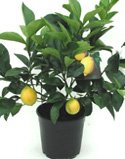






Water: Always water from the top. Water less often in winter without letting the pot dry out completely, and increase the amount of water once growth starts in the spring. As a general rule, when the top of the compost is beginning to dry out, give enough water to reach the bottom of the pot, preferably washing at least 10 % out through the bottom tipping any excess out of the saucer ten minutes after watering. Do not water again until the surface of the compost starts to dry again – this may be every day in summer, but not for 2 or 3 weeks in cool winter weather. The big pots take a lot of water, so enough must be given to reach the lower part of the pot (maybe several gallons). Be flexible about watering - judge the need by the look of the compost rather than the day of the week! Over-watering can cause problems too, by drowning the roots and creating stagnant soil conditions which encourage root diseases. With small plants it may be advisable to immerse the whole pot in water to thoroughly soak the compost and allow to drain. Citrus should never sit in water for long periods. During colder periods, compost should be kept dryer.
Feeding: Keep the top feeder roots of the tree covered with compost if possible. Trees should be fed weekly when actively growing with a citrus fertiliser (high in nitrogen and trace elements). Use summer formulation from March to September inclusive and the winter formulation fortnightly throughout the rest of the year, or weekly if the plant is growing actively at room temperature. If citrus food is not available, then a seaweed based fertiliser with added nitrogen is adequate . Foliar feeding can also be helpful in correcting deficiencies, this must only be done when the sun is not directly shining on the plant or the leaves may scorch. Too much feed may lead to scorching of the leaf tips, and it is a good idea to wash the compost through with lots of water once in summer and again in autumn to avoid a build up of fertiliser salts.
Pruning: To keep the trees in shape, pinch out the growing tip once a new branch is 10-15cm (4-6”) long. Regular pinching out of branches will encourage bushy growth nearer the middle of the tree, and this can be carried out at any time of year. Pruning of large branches is best done in February, just before growth starts speeding up, bearing in mind that citrus trees store excess food in their leaves, so removing too much leaf may result in a poor fruit crop.
Re-potting: In general it is best to re-pot just before or during the growing months, rather than in the autumn or winter. Either loam or peat-based composts can be used, mixed with extra sand or grit to improve drainage, and preferably crocks in the bottom of the pot. The ideal pH is 5-5.5, so a slightly acidic compost is beneficial. Loam based composts will give welcome increased stability for a tree outside, but it will also make large trees extremely heavy to move in and out of doors with the change of seasons. Where possible, pot up one size each time, with enough depth to cover the top feeder roots and give a 1” reservoir for water. In normal conservatory conditions, where the size of tree is to be restricted, a final pot size of 45cm will be adequate. Once it has reached this size pot, instead of re-potting into a larger size, take the rootball out of the pot at the end of February if it is overcrowded with roots, cut off about 2.5-5cm (1”-2”) all around the edges, and put back into the same pot with fresh compost around the edges or, if this has been done before with the same tree, remove 3 vertical triangles of compost from the rootball, and refill gaps. Try and roughly match the original compost, i.e. use a loam-based compost, if that has been used before. Keep the tree fairly cool and shaded for the following month, in order not to make great demand on the root system until it has started re-growing.
Pests: The most likely pests are aphids (greenfly), red spider mite and mealybug. These can be controlled with an appropriate off-the-shelf spray. Any product suitable for use on fruit and vegetables will do. Occasionally scale insect may settle on citrus, and can again be easily killed with an appropriate insecticide spray, or by dabbing with methylated spirit. As dead scale insect can harbour viable eggs under it, rubbing or scraping gently with a fingernail best removes any scales.
Contact Us: 07902 900301
Plant Passport Registration number UKEW102171
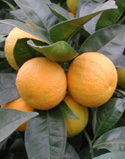
Lime Tahiti
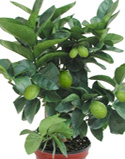
Buddha Half Grown
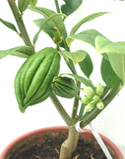
Buddha's Hand
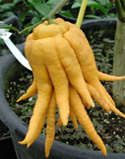
Tiger
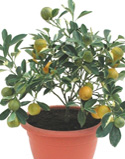
Lemon
